University Anthropology: Kinship, Elderly Roles, Cross-Culture Report
VerifiedAdded on 2022/10/02
|6
|1235
|344
Report
AI Summary
This report delves into the concept of kinship within cultural anthropology, exploring the relationships formed through blood and marriage, distinguishing between consanguineal and affinal kin. It examines family structures, particularly in the context of Japan and the United States, and discusses the roles of the elderly in various cultures. The report highlights the significance of cross-cultural communication, especially between generations, and analyzes the roles of elderly individuals in maintaining community values, providing guidance, and ensuring the well-being of younger generations. It also references personal family experiences and observations from fieldwork to illustrate the diverse perspectives on kinship and the elderly.
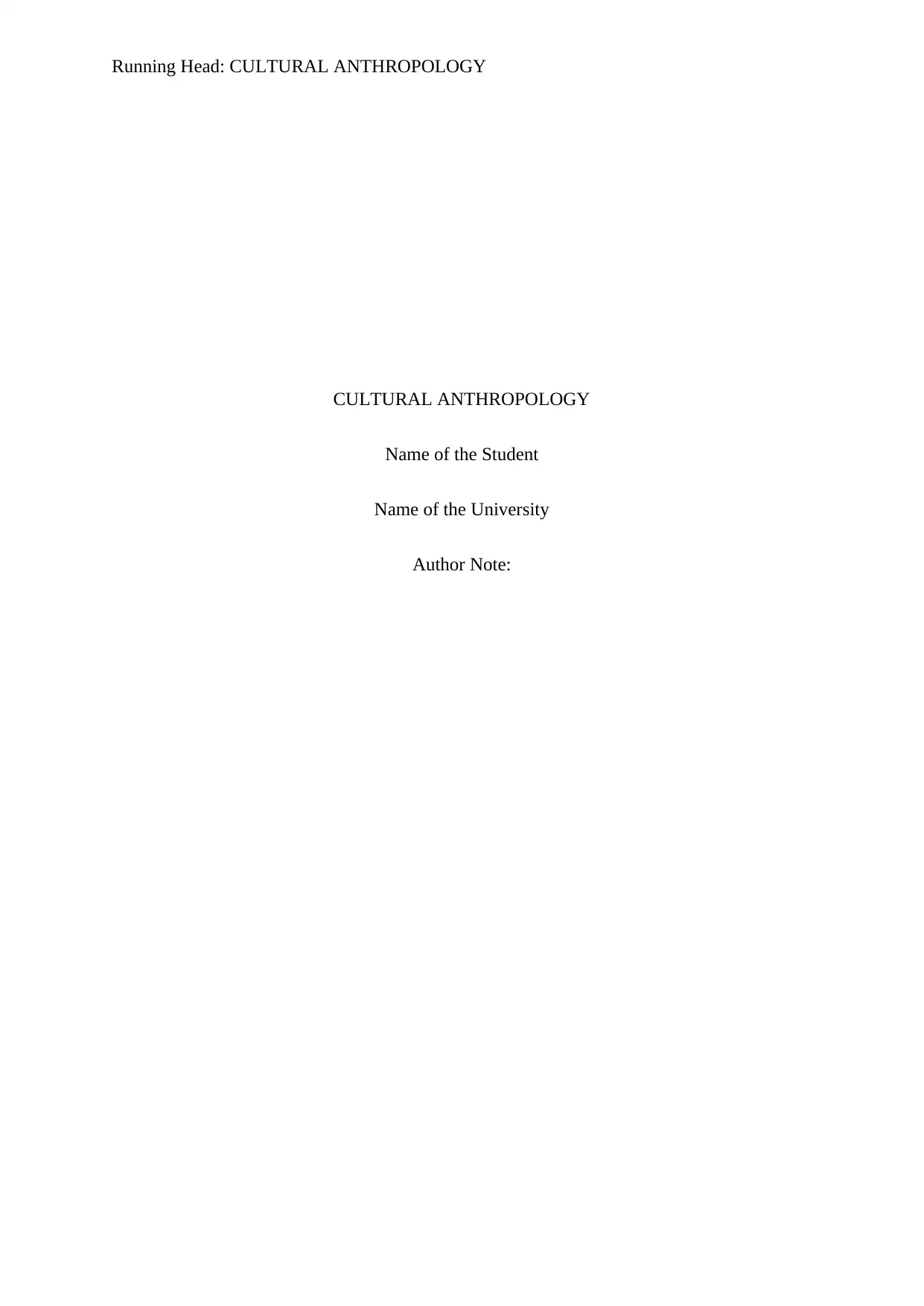
Running Head: CULTURAL ANTHROPOLOGY
CULTURAL ANTHROPOLOGY
Name of the Student
Name of the University
Author Note:
CULTURAL ANTHROPOLOGY
Name of the Student
Name of the University
Author Note:
Paraphrase This Document
Need a fresh take? Get an instant paraphrase of this document with our AI Paraphraser
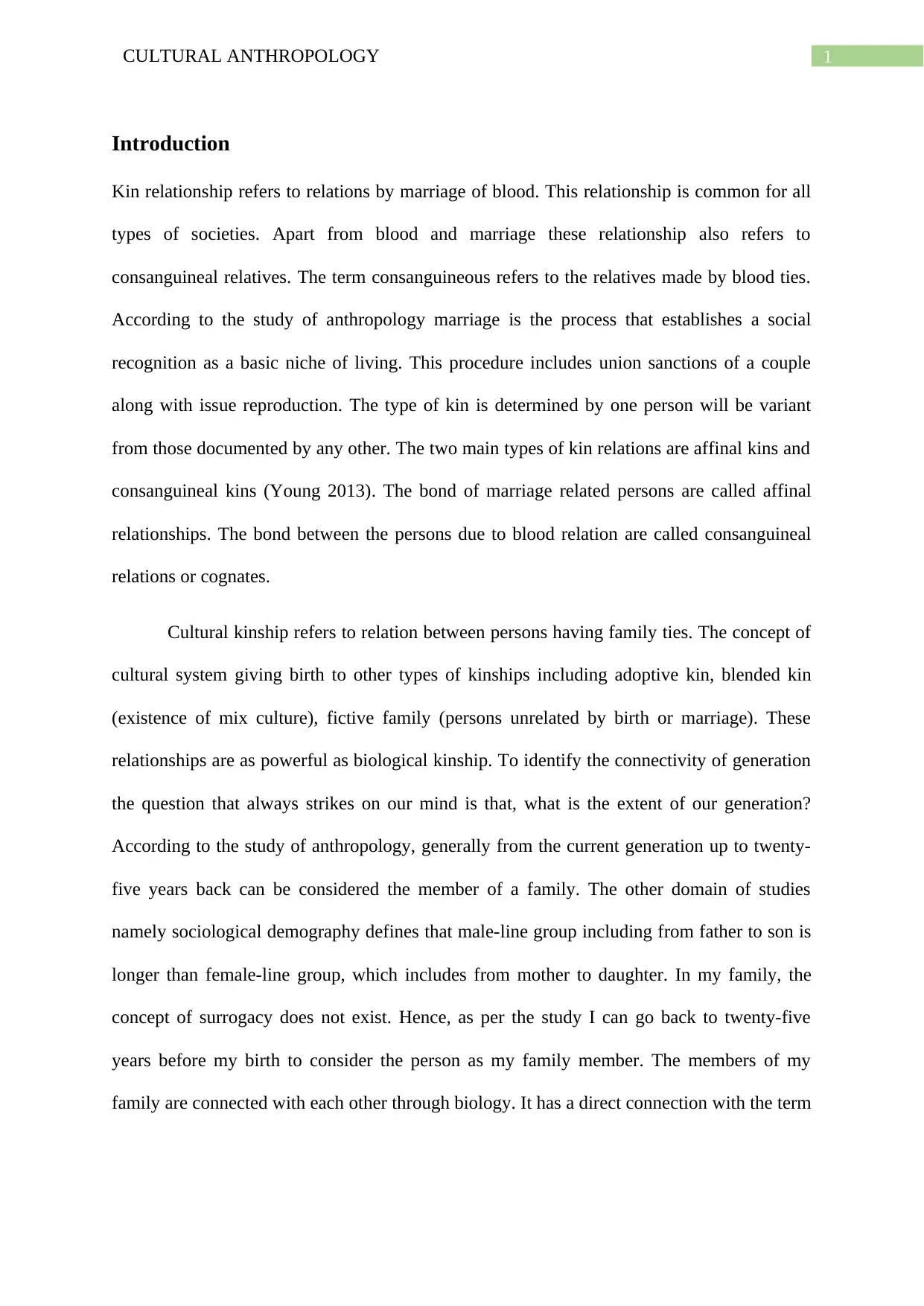
1CULTURAL ANTHROPOLOGY
Introduction
Kin relationship refers to relations by marriage of blood. This relationship is common for all
types of societies. Apart from blood and marriage these relationship also refers to
consanguineal relatives. The term consanguineous refers to the relatives made by blood ties.
According to the study of anthropology marriage is the process that establishes a social
recognition as a basic niche of living. This procedure includes union sanctions of a couple
along with issue reproduction. The type of kin is determined by one person will be variant
from those documented by any other. The two main types of kin relations are affinal kins and
consanguineal kins (Young 2013). The bond of marriage related persons are called affinal
relationships. The bond between the persons due to blood relation are called consanguineal
relations or cognates.
Cultural kinship refers to relation between persons having family ties. The concept of
cultural system giving birth to other types of kinships including adoptive kin, blended kin
(existence of mix culture), fictive family (persons unrelated by birth or marriage). These
relationships are as powerful as biological kinship. To identify the connectivity of generation
the question that always strikes on our mind is that, what is the extent of our generation?
According to the study of anthropology, generally from the current generation up to twenty-
five years back can be considered the member of a family. The other domain of studies
namely sociological demography defines that male-line group including from father to son is
longer than female-line group, which includes from mother to daughter. In my family, the
concept of surrogacy does not exist. Hence, as per the study I can go back to twenty-five
years before my birth to consider the person as my family member. The members of my
family are connected with each other through biology. It has a direct connection with the term
Introduction
Kin relationship refers to relations by marriage of blood. This relationship is common for all
types of societies. Apart from blood and marriage these relationship also refers to
consanguineal relatives. The term consanguineous refers to the relatives made by blood ties.
According to the study of anthropology marriage is the process that establishes a social
recognition as a basic niche of living. This procedure includes union sanctions of a couple
along with issue reproduction. The type of kin is determined by one person will be variant
from those documented by any other. The two main types of kin relations are affinal kins and
consanguineal kins (Young 2013). The bond of marriage related persons are called affinal
relationships. The bond between the persons due to blood relation are called consanguineal
relations or cognates.
Cultural kinship refers to relation between persons having family ties. The concept of
cultural system giving birth to other types of kinships including adoptive kin, blended kin
(existence of mix culture), fictive family (persons unrelated by birth or marriage). These
relationships are as powerful as biological kinship. To identify the connectivity of generation
the question that always strikes on our mind is that, what is the extent of our generation?
According to the study of anthropology, generally from the current generation up to twenty-
five years back can be considered the member of a family. The other domain of studies
namely sociological demography defines that male-line group including from father to son is
longer than female-line group, which includes from mother to daughter. In my family, the
concept of surrogacy does not exist. Hence, as per the study I can go back to twenty-five
years before my birth to consider the person as my family member. The members of my
family are connected with each other through biology. It has a direct connection with the term
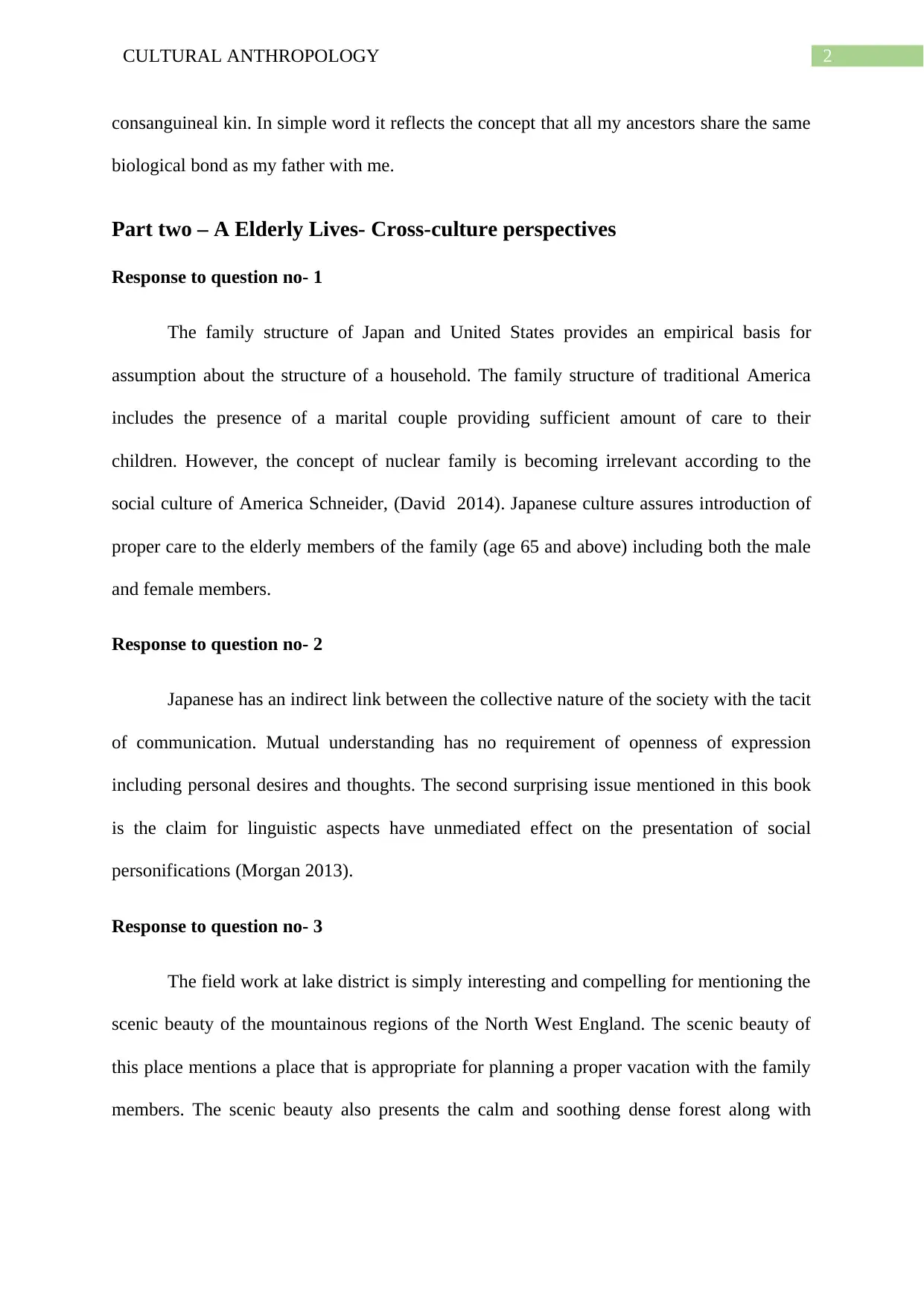
2CULTURAL ANTHROPOLOGY
consanguineal kin. In simple word it reflects the concept that all my ancestors share the same
biological bond as my father with me.
Part two – A Elderly Lives- Cross-culture perspectives
Response to question no- 1
The family structure of Japan and United States provides an empirical basis for
assumption about the structure of a household. The family structure of traditional America
includes the presence of a marital couple providing sufficient amount of care to their
children. However, the concept of nuclear family is becoming irrelevant according to the
social culture of America Schneider, (David 2014). Japanese culture assures introduction of
proper care to the elderly members of the family (age 65 and above) including both the male
and female members.
Response to question no- 2
Japanese has an indirect link between the collective nature of the society with the tacit
of communication. Mutual understanding has no requirement of openness of expression
including personal desires and thoughts. The second surprising issue mentioned in this book
is the claim for linguistic aspects have unmediated effect on the presentation of social
personifications (Morgan 2013).
Response to question no- 3
The field work at lake district is simply interesting and compelling for mentioning the
scenic beauty of the mountainous regions of the North West England. The scenic beauty of
this place mentions a place that is appropriate for planning a proper vacation with the family
members. The scenic beauty also presents the calm and soothing dense forest along with
consanguineal kin. In simple word it reflects the concept that all my ancestors share the same
biological bond as my father with me.
Part two – A Elderly Lives- Cross-culture perspectives
Response to question no- 1
The family structure of Japan and United States provides an empirical basis for
assumption about the structure of a household. The family structure of traditional America
includes the presence of a marital couple providing sufficient amount of care to their
children. However, the concept of nuclear family is becoming irrelevant according to the
social culture of America Schneider, (David 2014). Japanese culture assures introduction of
proper care to the elderly members of the family (age 65 and above) including both the male
and female members.
Response to question no- 2
Japanese has an indirect link between the collective nature of the society with the tacit
of communication. Mutual understanding has no requirement of openness of expression
including personal desires and thoughts. The second surprising issue mentioned in this book
is the claim for linguistic aspects have unmediated effect on the presentation of social
personifications (Morgan 2013).
Response to question no- 3
The field work at lake district is simply interesting and compelling for mentioning the
scenic beauty of the mountainous regions of the North West England. The scenic beauty of
this place mentions a place that is appropriate for planning a proper vacation with the family
members. The scenic beauty also presents the calm and soothing dense forest along with
⊘ This is a preview!⊘
Do you want full access?
Subscribe today to unlock all pages.

Trusted by 1+ million students worldwide
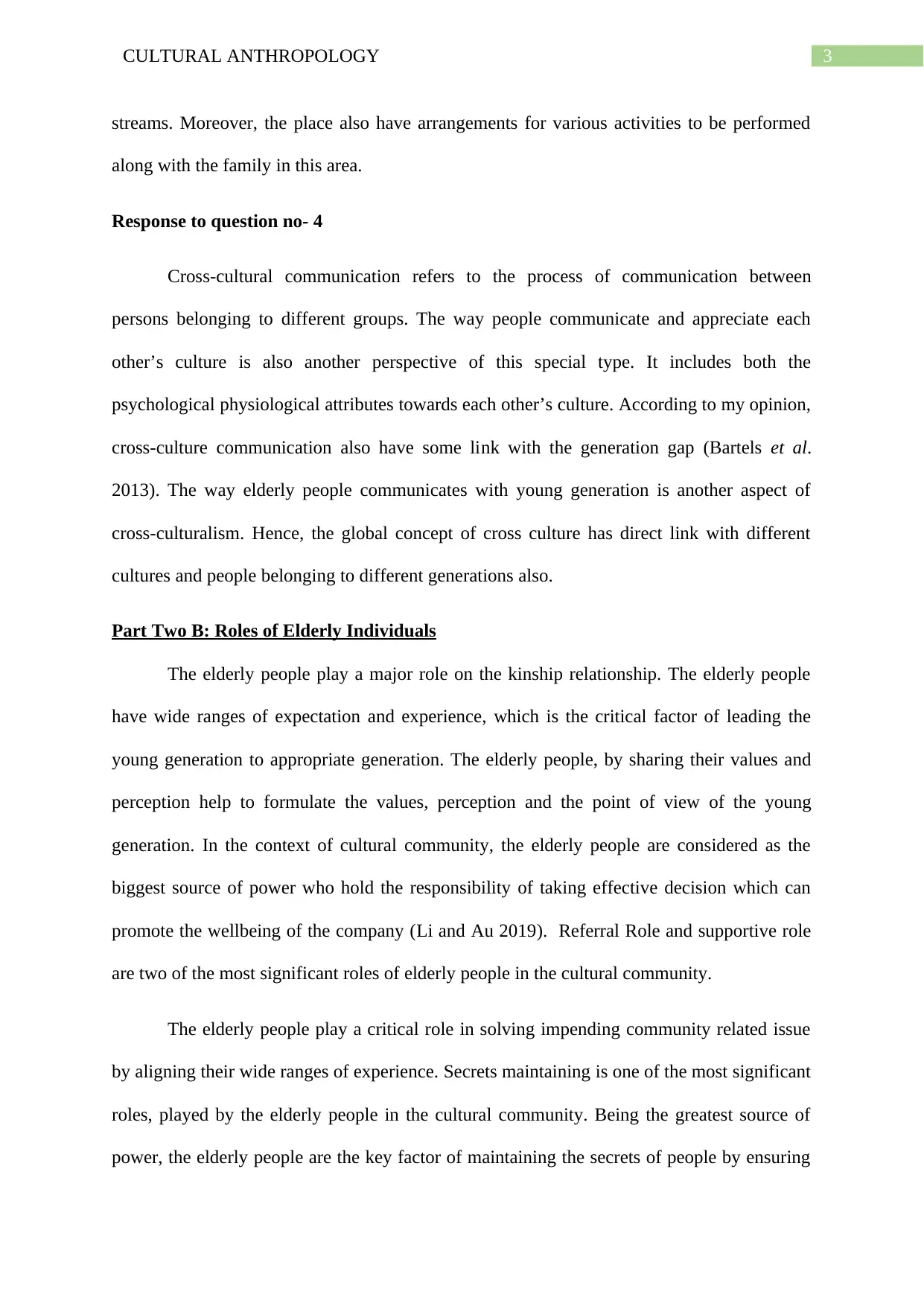
3CULTURAL ANTHROPOLOGY
streams. Moreover, the place also have arrangements for various activities to be performed
along with the family in this area.
Response to question no- 4
Cross-cultural communication refers to the process of communication between
persons belonging to different groups. The way people communicate and appreciate each
other’s culture is also another perspective of this special type. It includes both the
psychological physiological attributes towards each other’s culture. According to my opinion,
cross-culture communication also have some link with the generation gap (Bartels et al.
2013). The way elderly people communicates with young generation is another aspect of
cross-culturalism. Hence, the global concept of cross culture has direct link with different
cultures and people belonging to different generations also.
Part Two B: Roles of Elderly Individuals
The elderly people play a major role on the kinship relationship. The elderly people
have wide ranges of expectation and experience, which is the critical factor of leading the
young generation to appropriate generation. The elderly people, by sharing their values and
perception help to formulate the values, perception and the point of view of the young
generation. In the context of cultural community, the elderly people are considered as the
biggest source of power who hold the responsibility of taking effective decision which can
promote the wellbeing of the company (Li and Au 2019). Referral Role and supportive role
are two of the most significant roles of elderly people in the cultural community.
The elderly people play a critical role in solving impending community related issue
by aligning their wide ranges of experience. Secrets maintaining is one of the most significant
roles, played by the elderly people in the cultural community. Being the greatest source of
power, the elderly people are the key factor of maintaining the secrets of people by ensuring
streams. Moreover, the place also have arrangements for various activities to be performed
along with the family in this area.
Response to question no- 4
Cross-cultural communication refers to the process of communication between
persons belonging to different groups. The way people communicate and appreciate each
other’s culture is also another perspective of this special type. It includes both the
psychological physiological attributes towards each other’s culture. According to my opinion,
cross-culture communication also have some link with the generation gap (Bartels et al.
2013). The way elderly people communicates with young generation is another aspect of
cross-culturalism. Hence, the global concept of cross culture has direct link with different
cultures and people belonging to different generations also.
Part Two B: Roles of Elderly Individuals
The elderly people play a major role on the kinship relationship. The elderly people
have wide ranges of expectation and experience, which is the critical factor of leading the
young generation to appropriate generation. The elderly people, by sharing their values and
perception help to formulate the values, perception and the point of view of the young
generation. In the context of cultural community, the elderly people are considered as the
biggest source of power who hold the responsibility of taking effective decision which can
promote the wellbeing of the company (Li and Au 2019). Referral Role and supportive role
are two of the most significant roles of elderly people in the cultural community.
The elderly people play a critical role in solving impending community related issue
by aligning their wide ranges of experience. Secrets maintaining is one of the most significant
roles, played by the elderly people in the cultural community. Being the greatest source of
power, the elderly people are the key factor of maintaining the secrets of people by ensuring
Paraphrase This Document
Need a fresh take? Get an instant paraphrase of this document with our AI Paraphraser
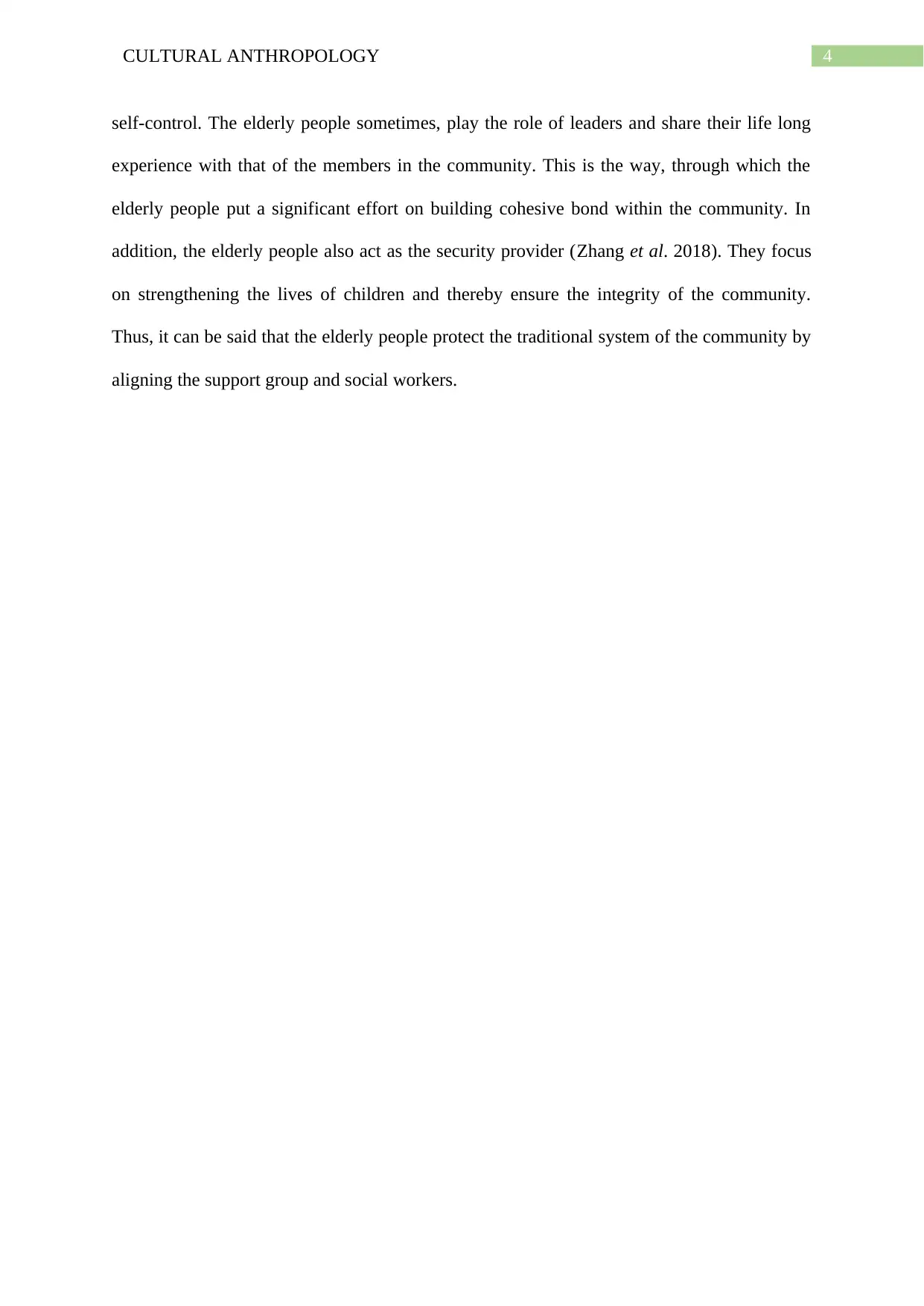
4CULTURAL ANTHROPOLOGY
self-control. The elderly people sometimes, play the role of leaders and share their life long
experience with that of the members in the community. This is the way, through which the
elderly people put a significant effort on building cohesive bond within the community. In
addition, the elderly people also act as the security provider (Zhang et al. 2018). They focus
on strengthening the lives of children and thereby ensure the integrity of the community.
Thus, it can be said that the elderly people protect the traditional system of the community by
aligning the support group and social workers.
self-control. The elderly people sometimes, play the role of leaders and share their life long
experience with that of the members in the community. This is the way, through which the
elderly people put a significant effort on building cohesive bond within the community. In
addition, the elderly people also act as the security provider (Zhang et al. 2018). They focus
on strengthening the lives of children and thereby ensure the integrity of the community.
Thus, it can be said that the elderly people protect the traditional system of the community by
aligning the support group and social workers.
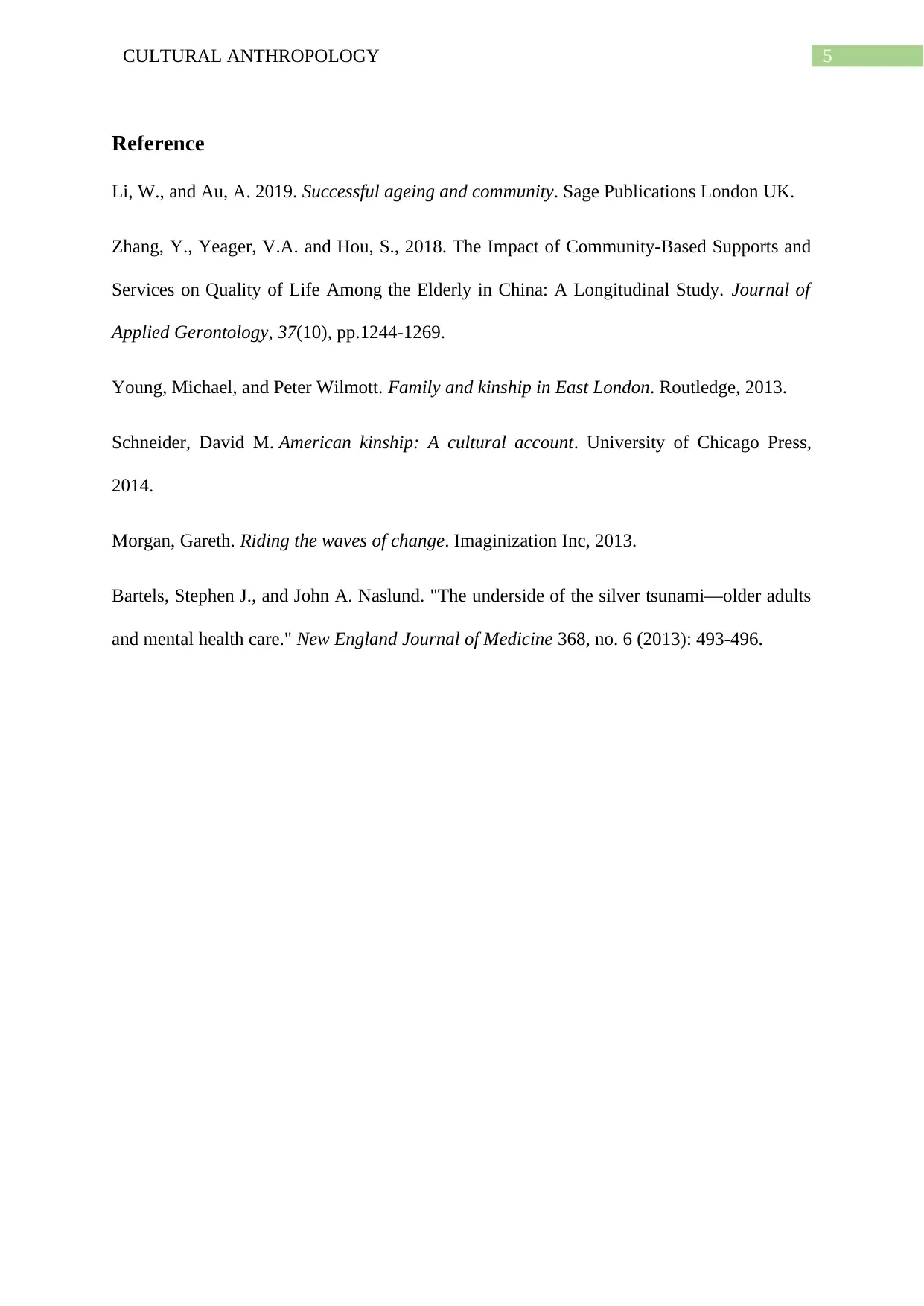
5CULTURAL ANTHROPOLOGY
Reference
Li, W., and Au, A. 2019. Successful ageing and community. Sage Publications London UK.
Zhang, Y., Yeager, V.A. and Hou, S., 2018. The Impact of Community-Based Supports and
Services on Quality of Life Among the Elderly in China: A Longitudinal Study. Journal of
Applied Gerontology, 37(10), pp.1244-1269.
Young, Michael, and Peter Wilmott. Family and kinship in East London. Routledge, 2013.
Schneider, David M. American kinship: A cultural account. University of Chicago Press,
2014.
Morgan, Gareth. Riding the waves of change. Imaginization Inc, 2013.
Bartels, Stephen J., and John A. Naslund. "The underside of the silver tsunami—older adults
and mental health care." New England Journal of Medicine 368, no. 6 (2013): 493-496.
Reference
Li, W., and Au, A. 2019. Successful ageing and community. Sage Publications London UK.
Zhang, Y., Yeager, V.A. and Hou, S., 2018. The Impact of Community-Based Supports and
Services on Quality of Life Among the Elderly in China: A Longitudinal Study. Journal of
Applied Gerontology, 37(10), pp.1244-1269.
Young, Michael, and Peter Wilmott. Family and kinship in East London. Routledge, 2013.
Schneider, David M. American kinship: A cultural account. University of Chicago Press,
2014.
Morgan, Gareth. Riding the waves of change. Imaginization Inc, 2013.
Bartels, Stephen J., and John A. Naslund. "The underside of the silver tsunami—older adults
and mental health care." New England Journal of Medicine 368, no. 6 (2013): 493-496.
⊘ This is a preview!⊘
Do you want full access?
Subscribe today to unlock all pages.

Trusted by 1+ million students worldwide
1 out of 6
Related Documents
Your All-in-One AI-Powered Toolkit for Academic Success.
+13062052269
info@desklib.com
Available 24*7 on WhatsApp / Email
![[object Object]](/_next/static/media/star-bottom.7253800d.svg)
Unlock your academic potential
Copyright © 2020–2025 A2Z Services. All Rights Reserved. Developed and managed by ZUCOL.



